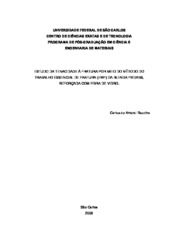| dc.contributor.author | Razzino, Carlos do Amaral | |
| dc.date.accessioned | 2016-06-02T19:10:01Z | |
| dc.date.available | 2009-11-13 | |
| dc.date.available | 2016-06-02T19:10:01Z | |
| dc.date.issued | 2008-06-05 | |
| dc.identifier.citation | RAZZINO, Carlos do Amaral. Study of the fracture toughness by essential work of fracture method (EWF) of glass fiber reinforced PBT/ABS blends. 2008. 145 f. Tese (Doutorado em Ciências Exatas e da Terra) - Universidade Federal de São Carlos, São Carlos, 2008. | por |
| dc.identifier.uri | https://repositorio.ufscar.br/handle/ufscar/662 | |
| dc.description.abstract | High rubber content acrylonitrile-butadiene-styrene terpolymer (ABS) has been used to tough PBT. As a result, super tough PBT/ABS blends under notched Izod impact have been obtained. However, there has been a significant reduction in the PBT/ABS Young modulus. The development of an optimum stiffness-toughness balance in PBT/ABS blends can be achieved by addition of short glass fibers to the composite blends. The composite performance is strongly dependent on the matrix-fiber interface and consequently the surface treatment of the fiber is a key factor to be considered. In the present work, the effect of two kinds of glass fibers treatment on the mechanical properties of PBT/ABS blends is investigated and the results discussed in terms of the changes of the fiber wettability and interfacial adhesion strength of the fiber to the resin. The processing conditions used to prepare glass fiber reinforced tough PBT/ABS blends were studied to observe the best conditions to maintain the toughness and stiffness of the blend as high as possible. A twin screw extrusion was used to prepare the reinforced PBT/ABS blends. Tensile, impact and essential work of fracture (EWF) testing was carried out to evaluate the mechanical properties for stiffness and toughness of the reinforced blends, respectively. The results have shown a strong dependence of the mechanical properties on the surface treatment of the fibers and these results are corroborated by electron microscopy micrographs that clearly illustrate the changes in the composite fiber/matrix interface in the presence of differences in surface treatments of the fiber. The development of an optimum stiffness-toughness balance in PBT/ABS blends was achieved and EWF has been successfully applied to evaluate the toughness for PBT/ABS blends. | eng |
| dc.description.sponsorship | Financiadora de Estudos e Projetos | |
| dc.format | application/pdf | por |
| dc.language | por | por |
| dc.publisher | Universidade Federal de São Carlos | por |
| dc.rights | Acesso Aberto | por |
| dc.subject | Polímeros | por |
| dc.subject | PBT/ABS | por |
| dc.subject | Compósitos poliméricos | por |
| dc.subject | Método EWF | por |
| dc.title | Estudo da tenacidade à fratura por meio do método do
trabalho essencial de fratura (EWF) da blenda PBT/ABS,
reforçada com fibra de vidro | por |
| dc.title.alternative | Study of the fracture toughness by essential work of fracture method (EWF) of glass fiber reinforced PBT/ABS blends | eng |
| dc.type | Tese | por |
| dc.contributor.advisor1 | Hage Júnior, Elias | |
| dc.contributor.advisor1Lattes | http://lattes.cnpq.br/1240692926327687 | por |
| dc.description.resumo | O terpolímero acrilonitrila-butadieno-estireno (ABS) com alto teor de borracha tem sido utilizado para tenacificar PBT. Como resultados, são obtidas blendas de PBT/ABS super tenazes sob impacto Izod entalhado. No entanto, ocorre uma redução significativa no módulo elástico. O desenvolvimento de um balanço de rigidez-tenacidade em blendas de PBT/ABS pode ser alcançado pela adição de fibras curtas de vidro. O desempenho dos compósitos é fortemente dependente da interface matriz-fibra e consequentemente o tratamento da superfície da fibra é um fator chave a ser considerado. No presente trabalho, foi investigado o efeito de dois tipos de tratamento de fibras de vidro nas propriedades mecânicas de blendas PBT/ABS e os resultados discutidos em termos das mudanças da molhabilidade da fibra e da adesão interfacial da fibra à resina. As condições de processo usadas para preparar as blendas de PBT/ABS reforçadas com fibra de vidro foram estudadas para observar as melhores condições para manter os valores de tenacidade e rigidez tão altos quanto possível. Uma extrusora dupla rosca foi usada para preparar as blendas de PBT/ABS reforçadas. Ensaios de tração, impacto e de tenacidade à fratura por meio do método do trabalho essencial de fratura (EWF) foram executados para avaliar as propriedades mecânicas de rigidez e tenacidade das blendas reforçadas. Os resultados mostraram uma forte dependência das propriedades mecânicas como o tratamento superficial das fibras e estes resultados são corroborados por micrografias de MEV, que claramente ilustram as mudanças na interface fibra/matriz em função das diferenças nos tratamentos superficiais das fibras. O desenvolvimento de um balanço de rigidez-tenacidade ótimo em blendas de PBT/ABS foi alcançado e o método EWF foi aplicado com sucesso para avaliar a tenacidade à fratura das blendas. | por |
| dc.publisher.country | BR | por |
| dc.publisher.initials | UFSCar | por |
| dc.publisher.program | Programa de Pós-Graduação em Ciência e Engenharia de Materiais - PPGCEM | por |
| dc.subject.cnpq | ENGENHARIAS::ENGENHARIA DE MATERIAIS E METALURGICA | por |
| dc.contributor.authorlattes | http://lattes.cnpq.br/2638794744443674 | por |
